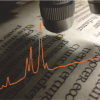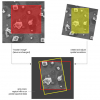José A. Heredia-Guerrero,a,* José J. Benítez,b Eva Domínguez,c Ilker S. Bayer,a Roberto Cingolani,a Athanassia Athanassioua and Antonio Herediac,d
aSmart Materials, Istituto Italiano di Tecnologia (IIT), Genova, Italy. E-mail: [email protected]
bInstituto de Ciencias de Materiales de Sevilla (ICMS), CSIC-US, Seville, Spain
cInstituto de Hortofruticultura Subtropical y Mediterránea (IHSM) La Mayora, CSIC-UMA, Málaga, Spain
dDepartamento de Bioquímica y Biología Molecular, Facultad de Ciencias, Universidad de Málaga, Málaga, Spain
Dedicated to the memory of José Heredia Romero
Introduction
Epidermal cells of fruits, petals, leaves and non-lignified stems are covered by a membrane called the cuticle.1 This cuticle is an important plant barrier with a unique architectural design which confers multiple functions. Its main function is to avoid massive water loss from internal tissues. Additionally, the cuticle is involved in defending the plant against pests and pathogens, reflecting and filtering potentially harmful ultraviolet radiation, and establishing organ boundaries during plant development. Furthermore, the cuticle plays a key role in fruit quality and postharvest performance, agronomical traits of great economic importance.

Figure 1. Scheme of the cross-section of a plant cuticle. The cuticle is located on the outermost region of the epidermal cell wall. From bottom to top, a polysaccharide-rich fraction in contact with the cell wall, a cutin fraction, that gives structural support to the cuticle and a thin layer of epicuticular waxes on the outer surface. Intracuticular waxes and phenolic compounds are distrib-uted throughout the cuticle.
The cuticle can be described as a heterogeneous and composite biopolymer,2 as depicted in Figure 1. It is mainly composed of cutin, an amorphous and non-soluble polyester formed by condensed polyhydroxylated fatty acids, which act as a solid matrix for the deposition of the other components. Polysaccharides derived from the epidermal cell wall, chiefly cellulose, hemicelluloses and pectin, are another important cuticle component. Waxes can be located either covering the outer surface (epicuticular waxes) or embedded in the cutin matrix (intracuticular waxes). They are mixtures of C20–C40n-alcohols, n-aldehydes, n-alkanes, fatty acids and esters. Cyclic compounds such as triterpenoids are also present in the wax fraction. Finally, a small fraction of phenolic compounds, mostly hydroxycinnamic acid derivatives and flavonoids, can be found within the cutin matrix.
The infrared spectrum of plant cuticles
Characterisation of plant cuticles by infrared (IR) spectroscopy has extensively provided valuable information about their chemical composition and structure.3 Thus, IR spectroscopy has been used in the identification of functional groups and their molecular environments in isolated cuticles, in the analysis of the interaction, distribution and molecular arrangement of cuticle components, and also in the study of interactions between the cuticle and water or exogenous substances and in the remote sensing of plant cuticles.

Figure 2. ATR/FT-IR spectra of isolated tomato fruit cuticle and its components. Main absorptions assigned to cutin (red), polysaccharides (green), waxes (blue) and phenolic compounds (orange) are indi-cated.
[ν, stretch; νa, antisymmetric stretch; νs, symmetric stretch; δ, deformation; δsc, δro, scissors and rock deformation vibration motions, respectively.]
Most plant cuticles show a similar IR spectroscopic profile. Figure 2 shows the attenuated total reflection Fourier transform infrared (ATR/FT-IR) spectra of an isolated tomato fruit cuticle. Five main spectral regions can be differentiated. The first region, ascribed to the stretching mode of hydroxyl groups interacting by hydrogen bonds, is located around 3400 cm–1. Main contributors to this band are polysaccharides and the non-esterified hydroxyl groups of cutin. In the second region two strong absorptions at ca 2920 cm–1 and 2850 cm–1, associated with the CH2 antisymmetric and symmetric stretching vibrations, respectively, can be observed. These bands are usually accompanied by CH2 bending vibrations at 1465 cm–1, 1315 cm–1 and 725 cm–1. They are mostly produced by fatty compounds of cuticle mainly present in cutin and waxes. In the third region, a strong peak at 1730 cm–1 (C=O stretching mode of esters) together with three shoulders at 1715 cm–1 (C=O stretching mode of esters interacting by hydrogen bonds), 1705 cm–1 (C=O stretching mode of carboxylic acids interacting by weak hydrogen bonds) and 1685 cm–1 (C=O stretching mode of carboxylic acids interacting by strong hydrogen bonds) are found. These bands can be attributed to the cutin matrix. In addition, other bands can be observed between 1650 cm–1 and 1500 cm–1. They are assigned to different aromatic and C=C chemical groups present in phenolic compounds. Aromatic molecules present in the cuticle are additionally characterised by two small bands at 816 cm–1 (C–H out-of-plane bend) and 518 cm–1 (C–C out-of-plane bend). Polysaccharides are featured by absorption at approximately 1030 cm–1 usually ascribed to the C–O stretching mode. Significant differences can be observed in cuticle spectra of different plants, organs and stages of development, although they display an overall common chemical composition. Moreover, environmental conditions can directly affect the chemical composition of the cuticle and, hence, its spectroscopic characteristics. Figure 2 also shows the ATR/FT-IR spectra of cutin, polysaccharides, waxes and phenolic compounds. The weighted sum of the spectra of each cuticle component closely reproduces the cuticle spectrum.4
Applications
The main applications of IR spectroscopy in the study of plant cuticles are associated with different disciplines: from plant physiology to palaeobotany and biophysics. In this section, the interaction of cuticle components with water and exogenous molecules, the spectroscopic changes in plant cuticles during plant development and the determination of semi-quantitative IR band ratios in palaeobotany will be described. Considering the modern applications of remote sensing techniques to monitor plant development in agriculture and forestry, the role of the cuticle in light reflection and also in filtering the energy spectrum emitted by this process will also be addressed.
Interaction of plant cuticles with water and exogenous molecules
Since the cuticle is the outer barrier of the parts of plant organs exposed to air, the analysis of water–cuticle and exogenous molecule–cuticle interactions is of great importance. IR spectroscopy has provided very useful information about such interactions. In the case of water, two different configurations of H2O molecules, volatile and embedded, were distinguished by FT-IR and near infrared (NIR) reflection spectroscopies,5 as illustrated in Figure 3. Some water molecules exhibited one weak hydrogen bond with the polysaccharide fraction of the cuticle. They were in equilibrium with the moisture and were designated as volatile H2O molecules. On the other hand, other water molecules were involved in two strong or three weak hydrogen bonds with cutin and polysaccharides, and were designated as embedded H2O molecules.

Figure 3. Interaction of water molecules in plant cuticles. Water molecules are shown in two different configurations, “volatile” and “embedded”. Infrared absorption stretching vibrations are indicated by double-headed arrows together with their corresponding wavenumbers. Adapted with permission from Maréchal and Chamel.5 Copyright 1996 American Chemical Society.
Sorption of some chemicals on plant cuticles has been also characterised by FT-IR spectroscopy.3 For instance, the analysis of isolated tomato fruit cuticles exposed to a flow of NO2 showed significant changes in the region of phenolic compounds, indicating an irreversible interaction of the NO2 with the aromatic fraction of the cuticle. Interestingly, the nitro functional group of the herbicides fenitrothion and parathion can interact with the polar functional groups of epicuticlar waxes, significantly reducing their resistance to photodegradation. Sorption of dimethyl sulfoxide showed a reversible interaction between the sulfoxide (S=O) chemical groups and the ester groups of cutin, which was characterised by a shift to lower wavenumber of the S=O stretching mode and an increase in intensity of the shoulder at 1715 cm–1.
Plant development
Another interesting and useful application of IR spectroscopy in the study of plant cuticles is the analysis of the chemical modifications that occur during plant development. In such an examination, cuticles of tomato fruits at different stages of development were characterised by ATR/FT-IR spectroscopy.6 The main spectroscopic changes were observed during ripening: an important increase of the area of the C–H out-of-plane bend band at 816 cm–1 (associated with 1,4-substituted aromatic rings from flavonoid molecules) and a reduction of the esterification index (the ratio between the intensities of the C=O stretching vibration of ester at ~1730 cm–1 and the antisymmetric vibration of methylene functional groups at ~2925 cm–1) of cutin. The temporal coordination of these two spectroscopic changes with fruit ripening suggests that the accumulation of phenolics and cutin depolymerisation may be correlated. This correlation was confirmed by analysing genetically modified tomatoes where the production of such flavonoids was silenced.7 Moreover, the absorbance intensity ratio ICOOR / ICOOH (measured as the ratio between the intensity of the C=O stretching vibrations of ester, 1730 cm–1 to that of the carboxylic acid, 1705 cm–1) showed high values for low C–H out-of-plane bending band areas, suggesting a hydrolysis or decreasing of the ester groups in cutin induced or regulated by the presence of phenolic compounds.
Palaeobotany
Infrared spectroscopic characterisation is employed in palaeobotany since the cuticle is commonly preserved in organic fossils, and is the main component of certain organic deposits. Typically, the characterisation is confined to the calculation of several semi-quantitative ratios of peak intensities in order to determine the chemical nature of fossilised plant cuticles.8 Some examples are the following intensity peak ratios: the methylene/methyl (related to aliphatic chain length and degree of branching of aliphatic side groups), the aliphatic/oxygen-containing compounds (associated with the oxidation of organic matter), the aromatic C–H out-of-plane bending/aliphatic (indicative of the aromatic in the organic matter) and the aromatic C–H out-of-plane bending/aromatic carbon groups (used as a measure of the degree of condensation of aromatic rings).
Remote sensing
The current knowledge on the IR spectroscopic features of plant cuticles has been used for remote sensing.9 In this sense, field spectral emissivity measurements of leaves in the thermal infrared spectral region have been carried out. Such measurements are difficult, however, to obtain because the sensors must have a small enough instantaneous field of view and high signal-to-noise ratios. Moreover, different mathematical refinements for atmospheric compensation, temperature–emissivity separation and spectral feature analysis are necessary. Despite all this, interesting spectral differences among plant species can be observed and they have been proposed for mapping vegetation composition even from space operations such as the NASA Hyperspectral InfraRed Imager (HyspIRI) mission.10 Specifically, in the case of cutin, the most useful band to detect this biopolyester was the antisymmetric C–O–C stretching mode assigned to the ester functional groups.
Concluding remarks
Infrared spectroscopy is a very useful tool for the characterisation of plant cuticles. It has provided valuable knowledge about the identification of functional groups, chemical structure and arrangement and interactions of plant cuticle components. Additionally, it has been indispensable in the study of interactions with water or other exogenous molecules. Furthermore, it has been useful in revealing the chemical modifications occurring during plant development and in the analysis of preserved cuticles in organic fossils. Moreover, recently a new technology has been developed for remote sensing. However, these applications should be accompanied by other physicochemical characterisations. In this sense, the different modes of Raman microscopy developed for chemical imaging are complementary techniques. Also, the qualitative and quantitative compositional analysis of cuticle components by nuclear magnetic resonance and gas chromatography is recommended.
Furthermore, other typical IR techniques, commonly used for the analysis of thin films, could be employed in the study of plant cuticles. For example, the use of variable angle ATR/FT-IR could allow for the study of chemical depth profiles, while the control of the temperature would permit one to analyse the melting of waxes or the breaking of hydrogen bonds. Additionally, the polarisation of the infrared light would be useful in the detection of preferential orientations or crystalline domains of the different cuticle components. Additionally, ATR/FT-IR spectroscopy could be used for the determination of coefficients of diffusion of water or exogenous molecules through the cuticle. Another possibility to consider would be the use of IR spectroscopic analysis to carry out initial screenings of genetically modified plant cuticles.
Finally, it is important to emphasise that the number of plant cuticles of different species analysed is still low. Extrapolation of data and conclusions to other plants species could be erroneous. Thus, more studies by IR spectroscopy are necessary in the future for a better understanding of this complex and important plant barrier membrane.
Acknowledgements
José A. Heredia-Guerrero is supported by a Marie Curie Intra-European Fellowship, financed by the EU’s Seventh Framework Programme for Research (FP7). Additional funding was provided by the Consejería de Innovación, Ciencia y Empresa (Andalusian Government) grant TEP-7418.
References
- E. Domínguez, J.A. Heredia-Guerrero and A. Heredia, “Plant cutin genesis: unanswered questions”, Trends Plant Sci. 20, 551–558 (2015). doi: http://dx.doi.org/10.1016/j.tplants.2015.05.009
- E. Domínguez, J.A. Heredia-Guerrero and A. Heredia, “The biophysical design of plant cuticles: an overview”, New Phytol. 189, 938–949 (2011). doi: http://dx.doi.org/10.1111/j.1469-8137.2010.03553.x
- J.A. Heredia-Guerrero, J.J. Benítez, E. Domínguez, I.S. Bayer, R. Cingolani, A. Athanassiou and A. Heredia, “Infrared and Raman spectroscopic features of plant cuticles: a review”, Front. Plant Sci. 5, 305 (2014). doi: http://dx.doi.org/10.3389/fpls.2014.00305
- B. Ribeiro da Luz, “Attenuated total reflectance spectroscopy of plant leaves: a tool for ecological and botanical surfaces”, New Phytol. 172, 305–318 (2006). doi: http://dx.doi.org/10.1111/j.1469-8137.2006.01823.x
- Y. Maréchal and A. Chamel, “Water in a biomembrane by infrared spectroscopy”, J. Phys. Chem. 100, 8551–8555 (1996). doi: http://dx.doi.org/10.1021/jp951981i
- L. España, J.A. Heredia-Guerrero, P. Segado, J.J. Benítez, A. Heredia and E. Domínguez, “Biomechanical properties of the tomato (Solanum lycopersicum) fruit cuticle during development are modulated by changes in the relative amounts of its components”, New Phytol. 202, 790–802 (2014). doi: http://dx.doi.org/10.1111/nph.12727
- L. España, J.A. Heredia-Guerrero, J.J. Reina-Pinto, R. Fernández-Muñoz, A. Heredia and E. Domínguez, “Transient silencing of CHALCONE SYNTHASE during fruit ripening modifies tomato epidermal cells and cuticle properties”, Plant Physiol. 166, 1371–1386 (2014). doi: http://dx.doi.org/10.1104/pp.114.246405
- E.L. Zodrow, J.A. D’Angelo, R. Helleur and Z. Šimuºnek, “Functional groups and common pyrolysate products of Odontopteris cantabrica (index fossil for the Cantabrian Substage, Carboniferous)”, Int. J. Coal Geol. 100, 40–50 (2012). doi: http://dx.doi.org/10.1016/j.coa1.2012.06.002
- B. Ribeiro da Luz and J.K. Crowley, “Spectral reflectance and emissivity features of broad leaf plants: prospects for remote sensing in the thermal infrared (8.0–14.0 μm)”, Remote Sens. Environ. 109, 393–405 (2007). doi: http://dx.doi.org/10.1016/j.rse.2007.01.008
- C.M. Lee, M.L. Cable, S.J. Hook, R.O. Green, S.L. Ustin, D.J. Mandl and E.M. Middleton, “An introduction to the NASA Hyperspectral InfraRed Imager (HyspIRI) mission and preparatory activities”, Remote Sens. Environ. 167, 6–19 (2015). doi: http://dx.doi.org/10.1016/j.rse.2015.06.012






